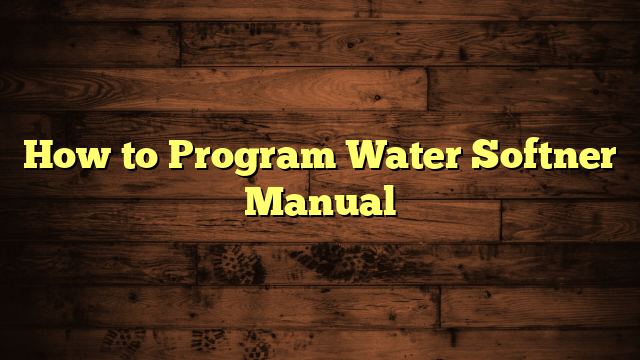How to Fix Culligan Water Softner Faliure to Rinse?
If your Culligan water softener isn't rinsing properly, you've got several potential issues to reflect on. Start by checking the brine tank for salt levels and verify the system settings match your water usage. It's also wise to inspect the water supply for pressure and flow rate. These steps could lead you to the root of the problem, but what if you've covered all the basics and the issue still persists? Understanding the next steps can be essential to restoring your softener's functionality.
Key Takeaways
- Check and adjust the regeneration cycle settings to ensure it aligns with your water usage for effective rinsing.
- Inspect the brine tank for salt bridges and ensure salt levels are maintained at half full for optimal brine production.
- Assess water pressure and flow rates; ideal pressure is between 40 to 60 psi for proper rinsing.
- Look for leaks or blockages in supply lines that may disrupt water flow during the rinsing process.
- If issues persist, consider consulting a professional to diagnose and repair any malfunctioning components.
Common Causes of Rinse Failure
When your Culligan water softener fails to rinse properly, it can stem from several common issues. One primary culprit is resin fouling. Over time, the resin beads inside your softener can become coated with minerals, iron, or organic matter, preventing them from functioning effectively. If you notice a buildup, it's crucial to clean the resin to restore peak performance.
Another common issue is salt bridging. This occurs when a hard crust forms on the surface of the salt in the brine tank, creating an air gap that prevents the salt from dissolving properly. As a result, your softener can't regenerate effectively, leading to inadequate rinsing. To fix this, you'll need to break up the bridge by inserting a broomstick or similar object into the tank and gently breaking the crust.
Regular maintenance and monitoring can help you catch these issues early. Make it a habit to check your salt levels and inspect the resin for fouling.
Checking the System Settings
Before tackling rinse issues with your Culligan water softener, it's essential to check the system settings.
Start by verifying that the control settings align with your water usage needs, as incorrect settings can lead to failures.
Furthermore, adjusting the timer settings may help optimize the rinse cycle and restore proper function.
Verify Control Settings
Start by checking the control settings on your Culligan water softener, as incorrect configurations can lead to rinsing failures.
Head over to the control panel and take a close look at the displayed settings. Confirm that the system is set to the appropriate mode for your water hardness level. Sometimes, a simple oversight in the setting adjustments can cause significant issues.
Next, verify that the regeneration cycle is properly configured. If the cycle isn't set to run at the right intervals, it may not rinse effectively.
Double-check that the salt dosage settings match your usage needs as well. Too little salt can hinder the softening process, leading to problems during the rinse cycle.
If you notice any discrepancies in the settings, make the necessary adjustments. It's essential to follow the manufacturer's guidelines while doing this.
After making changes, give your water softener some time to reset and then observe if the rinsing improves.
Regularly reviewing your control settings can help prevent future failures and keep your system running smoothly.
Adjust Timer Settings
After verifying the control settings, the next step is to adjust the timer settings on your Culligan water softener. Proper timer adjustment is essential for guaranteeing your system operates efficiently.
First, locate the timer on your unit; it's usually a digital display or dial. Check the current time and the regeneration schedule. If the timer's not set correctly, it can lead to inadequate rinsing.
For effective programming, consider these tips: Set the regeneration cycle to occur during off-peak hours, typically at night. This guarantees your softener runs when you're not using water, allowing it to function without interruption.
Furthermore, make sure the duration of the cycle matches the hardness of your water; harder water may require longer cycles.
Once you've made the necessary adjustments, monitor the system for a few days to confirm it rinses properly. If you notice issues persisting, revisit your settings and make further tweaks as needed.
Inspecting the Brine Tank
Inspecting the brine tank is essential for troubleshooting your Culligan water softener. First, check the salt level in the brine tank. If the salt is low, your system won't produce enough brine for regeneration, leading to rinsing issues. Aim for a salt level of about half full; topping it off guarantees peak performance.
Next, look for any salt bridges or crusts at the top of the salt pile. Salt bridges can form when the salt hardens and creates a barrier, preventing the water from dissolving it. If you find a bridge, you can try breaking it up with a broomstick or similar tool, but be careful not to damage the tank.
Additionally, inspect the brine tank for any leaks or cracks. A leak can cause a loss of brine, affecting the softening process. If you notice any signs of wear, it might be time to replace the tank.
Finally, take a moment to clean the brine tank if it shows signs of sludge or residue. Regular maintenance will help your water softener operate smoothly, guaranteeing you get the most out of your system.
Cleaning the Resin Beads
How often do you think about cleaning the resin beads in your Culligan water softener? If you're like most homeowners, it probably doesn't cross your mind often enough.
However, resin maintenance is essential for ensuring your water softener operates efficiently. Over time, these beads can accumulate dirt, minerals, and other impurities, hindering their ability to effectively soften water.
To start bead cleaning, first, turn off your water softener and unplug it. Then, drain the brine tank to remove any leftover salt and water.
Next, prepare a cleaning solution using a resin cleaner, following the manufacturer's instructions. Pour the solution into the brine tank, and let it sit for the recommended time, usually a few hours. This allows the cleaner to penetrate and break down the buildup on the resin beads.
Afterward, run a regeneration cycle to rinse the beads thoroughly, flushing out the cleaning solution along with any contaminants.
Finally, refill the brine tank with fresh salt. Regular bead cleaning, performed every six months or so, can greatly enhance your softener's performance and longevity.
Examining the Water Supply
Before addressing your Culligan water softener's rinsing issues, it's vital to check your water supply.
Start by evaluating the water pressure; low pressure can hinder proper rinsing.
Furthermore, inspecting the supply lines for any leaks or blockages will guarantee that your system has the necessary flow to function effectively.
Water Pressure Assessment
When troubleshooting a Culligan water softener that fails to rinse properly, evaluating your water pressure is essential.
Start by checking the water flow into the unit. You can do this by using a pressure gauge; simply attach it to the nearest faucet and turn on the water. A pressure reading between 40 to 60 psi is ideal for maximum performance. If your reading is below this range, it could indicate insufficient pressure affecting the softener's ability to rinse effectively.
Next, consider the water flow rate. If it's too low, the softener mightn't have enough water to perform the rinse cycle adequately.
You can test the flow rate by filling a container of known volume and timing how long it takes to fill it. If it takes longer than expected, you may need to investigate potential blockages or other issues in your plumbing system.
Supply Line Inspection
Inspecting your supply lines can uncover issues that may hinder your Culligan water softener's rinse cycle. First, check for any supply line blockage or leaks that could disrupt the water flow. A thorough visual inspection can reveal cracks or loose connections, which may lead to leaks.
Here's a quick reference table to help you identify potential issues:
| Issue | Signs to Watch For |
|---|---|
| Supply Line Blockage | Weak water flow or no water at all |
| Supply Line Leaks | Water pooling around connections |
| General Wear and Tear | Cracks, corrosion, or bent lines |
If you notice a blockage, consider flushing the line. For leaks, tightening connections or replacing damaged sections can often solve the problem. Remember, even small leaks can considerably impact the softener's efficiency. By keeping your supply lines in good condition, you guarantee that your Culligan water softener operates effectively and maintains its rinse cycle. Regular inspections can prevent bigger issues down the line, saving you time and money in repairs.
Replacing Faulty Parts
Replacing faulty parts in your Culligan water softener is vital for restoring its proper function and guaranteeing efficient performance. When you notice your unit failing to rinse, it's time to identify any faulty components that might be causing the issue. Common culprits include the control valve, resin tank, or brine injector.
To replace these parts, follow the replacement guidelines provided in your user manual. Start by turning off the power and water supply to your softener. Carefully remove the faulty component, making sure you note any connections or specific placements.
When installing the new part, make certain it fits securely and reattach any hoses or wires as needed. Once everything is back in place, turn the water supply on and test the system.
It's essential to check for leaks and verify the softener rinses properly. By replacing faulty components, you'll not only improve your water softener's performance but also extend its lifespan.
When to Call a Professional
Knowing when to call a professional for your Culligan water softener can save you time and frustration. If you've followed all troubleshooting steps and your softener still won't rinse, it's time to reach out for help. While many issues can be fixed with a little DIY effort, some problems require specialized knowledge and tools.
Consider contacting a professional if you notice persistent error codes that don't resolve with simple resets or if your unit leaks water. These signs often indicate underlying issues that could lead to further damage if not addressed promptly.
Professional maintenance can guarantee your system operates efficiently and prolong its lifespan. Additionally, if you're uncomfortable with electrical components or water connections, it's best to leave it to the experts. They can provide troubleshooting assistance that you mightn't be able to achieve on your own.
A trained technician can diagnose problems accurately and offer solutions that may not be apparent to a homeowner. Ultimately, knowing your limits is essential. Don't hesitate to call a professional if you're unsure about a repair—your peace of mind is worth it!
Frequently Asked Questions
How Often Should I Maintain My Culligan Water Softener?
You should perform routine checks on your Culligan water softener every six months. Regular softener maintenance helps guarantee peak performance, preventing issues and extending the lifespan of your unit while keeping your water quality high.
Can I Troubleshoot a Rinse Failure Myself?
Like a detective unraveling a mystery, you can troubleshoot a rinse failure yourself. Check the rinse cycle settings, inspect the valve, and follow troubleshooting tips in your manual to restore smooth operation.
What Are the Signs of a Failing Water Softener?
You'll notice signs of a failing water softener through poor water quality, like hard water spots and decreased suds. Regular maintenance tips, such as checking salt levels, can help prevent these issues before they worsen.
Is Hard Water Harmful to My Plumbing?
Yes, hard water can harm your plumbing. It creates scale buildup, clogs pipes, and increases plumbing maintenance costs. If you notice reduced water flow or leaks, it's time to address hard water effects in your home.
How Long Do Culligan Water Softeners Typically Last?
Culligan water softeners typically last around 10 to 15 years with proper care. To maximize their lifetime expectancy, follow maintenance tips like regular cleaning and replacing filters, ensuring your system runs efficiently for years.
Conclusion
To sum up, addressing a Culligan water softener's rinse failure involves a systematic approach, much like piecing together a puzzle. By checking system settings, inspecting the brine tank, and examining the water supply, you can often pinpoint the issue. If problems persist after cleaning the resin beads or replacing faulty parts, don't hesitate to call a professional. With a bit of diligence, you'll have your water softener back to peak performance, ensuring your water remains soft and pleasant.







